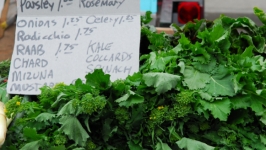Spinach Recipes & Info
Discover | Most farmers in southeast Michigan plant their spinach in mid-April. Cool weather plants can tolerate lower temperatures and even a light frost. This hardy plant is packed with nutrients and is inexpensive. Eating spinach is as easy as just tossing a handful into your morning eggs or into your favorite marinara sauce.
Taste | Fresh spinach is a tender leafy green with a mild flavor and soft texture. The flat-leafed variety— including the popular baby variety—is delicate and smooth. The savory or curly variety has a stronger, almost bitter flavor and more crunch. A delicious and versatile vegetable, spinach can be added to almost anything, including juices and smoothies.
Fortify | Spinach may just be one of the most nutrient-dense foods available. Loaded with vitamin C, vitamin A, vitamin K, iron, folate and fiber, spinach provides more nutrition per calorie than almost any other vegetable. Spinach is considered one of the top “superfoods”—nutrient powerhouses that improve long-term health—recommended to eat daily.
Preserve | Spinach tastes best on the day of harvest, but can also be stored in the refrigerator. Wrap unwashed spinach in a paper towel and place in a plastic bag. Fresh spinach requires little preparation except washing. Place in a large sink full of cold water, and the dirt should fall to the bottom. Keep in mind that spinach will shrink down to barely 10% of its original volume when cooked. After cooling, cooked spinach freezes well in an airtight freezer-safe bag for up to one year








